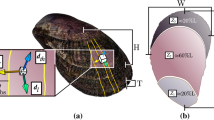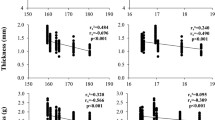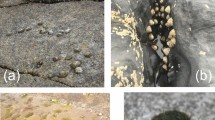Abstract
The calcareous exoskeletons of bivalve molluscs protect the organisms from environmental stressors, including physical loads like impacts (e.g., from wave-borne rocks) and compressions (e.g., from predators). The magnitude and time scales of physical loads can occur over a wide range of values, and little is known about how the strength of bivalve shells are affected by the speed of impact or compression. We used the intertidal mussel Mytilus californianus to test how the rate of compression affects the strength of the mussel’s shell. Shell strength was time-dependent, and shells withstood 11.5% larger loads if those loads were applied quickly than if they were applied slowly. We then tested whether the shell’s time-dependent strength could influence the strategy of predators trying to compress and fracture the shells. Between strategies with the same compression rate, using more force reduced the time and mechanical work to fracture shells. However, between strategies with the same force, compressing shells slowly reduced the time required to fracture large shells, while the opposite was true for small shells. These results indicate that shell strength is not a static property. Time-dependent strength can influence the interactions between mussels and the physical loads they experience in nature, including their interactions with predators. Studies investigating the influence of climate change on the architecture and strength of mollusc shells should incorporate a range of ecologically relevant compression rates in their measurements to better understand how climate change will affect these organisms.




Similar content being viewed by others
References
Alexander RM (1981) Factors of safety in the structure of animals. Sci Prog 67:109–130
Barthelat F, Tang H, Zavattieri PD, Li CM, Espinosa HD (2007) On the mechanics of mother-of-pearl: a key feature in the material hierarchical structure. J Mech Phys Solids 55:306–337
Bayne BL (1976) Marine mussels: their ecology and physiology. Cambridge University Press, Cambridge
Beedham GE (1965) Repair of the shell in species of Anodonta. Proc Zool Soc Lond 145:107–124
Bertness MD, Crain CM, Silliman BR, Bazterrica MC, Reyna MV, Hildago F, Farina JK (2006) The community structure of western Atlantic Patagonian rocky shores. Ecol Monogr 76:439–460
Boulding EG, LaBarbera M (1986) Fatigue damage: repeated loading enables crabs to open larger bivalves. Biol Bull 171:538–547
Buschbaum C, Buschbaum G, Schrey I, Thieltges DW (2007) Shell-boring polychaetes affect gastropod shell strength and crab predation. Mar Ecol Prog Ser 329:123–130
Cai W, Borlace S, Lengaigne M, van Rensch P, Collins M, Vecchi G, Timmermann A, Santoso A, McPhaden MJ, Wu L, England MH, Wang G, Guilyardi E, Jin F (2014) Increasing frequency of extreme El Niño events due to greenhouse warming. Nat Clim Change 5:1–6
Coffey WD, Nardone JA, Yarram A, Long WC, Swiney KM, Foy RJ, Dickinson GH (2017) Ocean acidification leads to altered micromechanical properties of the mineralized cuticle in juvenile red and blue king crabs. J Exp Mar Biol Ecol 495:1–12
Currey JD (1977) Mechanical properties of mother of pearl in tension. Proc R Soc Lond B 196:443–463
Davenport J, O’Callaghan MJA, Davenport JL, Kelly TC (2014) Mussel dropping by Carrion and Hooded crows: biomechanical and energetic considerations. J Field Ornithol 85:196–205
Dayton PK (1971) Competition, disturbance, and community organization: the provision and subsequent utilization of space in a rocky intertidal community. Ecol Monogr 41:351–389
Dodd JR (1963) Palaeoecological implications of shell mineralogy in two pelecypod species. J Geol 71:1–11
Dodd JR (1965) Environmental control of strontium and magnesium in Mytilus. Geochim et Cosmochim Act 29:385–398
Dodd LF, Grabowski JH, Piehler MF, Westfield I, Ries JB (2015) Ocean acidification impairs crab foraging behavior. Proc R Soc B 282:20150333
Elner R (1978) The mechanics of predation by the shore crab, Carcinus maenas (L.), on the edible mussel, Mytilus edulis L. Oecologia 36:333–344
Elner RW, Campbell A (1981) Force, function and mechanical advantage in the chelae of the American lobster Homarus americanus (Decapoda: Crustacea). J Zool 193:269–286
Gazeau F, Parker LM, Comeau S, Gattuso JP, O’Connor WA, Martin S, Pӧrtner HO, Ross PM (2013) Impacts of ocean acidification on marine shelled molluscs. Mar Biol 160:2207–2245
Hamza S, Slimane N, Azari Z, Pluvinage G (2013) Structural and mechanical properties of the coral and nacre and the potential of their use as bone substitutes. Appl Surf Sci 264:485–491
Jackson AP, Vincent JFV, Turner RM (1988) The mechanical design of nacre. Proc R Soc Lond B 234:415–440
Landes A, Zimmer M (2012) Acidification and warming affect both a calcifying predator and prey, but not their interaction. Mar Ecol Prog Ser 450:1–10
Li S, Liu C, Huang J, Liu Y, Zheng G, Xie L, Zhang R (2015) Interactive effects of seawater acidification and elevated temperature on biomineralization and amino acid metabolism in the mussel Mytilus edulis. J Exp Biol 218:3623–3631
Mackenzie CL, Ormondroyd GA, Curling SF, Ball RJ, Whiteley NM, Malham SK (2014) Ocean warming, more than acidification, reduces shell strength in a commercial shellfish species during food limitation. PLoS ONE 9:e86764
McGuinness KA (1987) Disturbance and organisms on boulders. I. Patterns in the environment and the community. Oecologia 71:409–419
McKinney RA, Glatt SM, McWilliams SR (2004) Allometric length-weight relationships for benthic prey of aquatic wildlife in coastal marine habitats. Wildl Biol 10:241–249
Melzner F, Stange P, Trübenbach K, Thomsen J, Casties I, Panknin U, Gorb SN, Gutowska MA (2011) Food supply and seawater pCO2 impact calcification and internal shell dissolution in the blue mussel Mytilus edulis. PLoS ONE 6:e24223
Miller LP, O’Donnell MJ, Mach KJ (2007) Dislodged but not dead: survivorship of a high intertidal snail following wave dislodgement. J Mar Biol Assoc UK 87:735–739
Newell RIE (2004) Ecosystem influences of natural and cultivated populations of suspension-feeding bivalve molluscs: a review. J Shellfish Biol 23:51–61
O’Donnell MJ, George MN, Carrington E (2013) Mussel byssus attachment weakened by ocean acidification. Nat Clim Change 3:587–590
Paine RT, Levin SA (1981) Intertidal landscapes: disturbance and the dynamics of pattern. Ecol Monogr 51:145–178
Palmer AR (1992) Calcification in marine molluscs: how costly is it? Proc Natl Acad Sci 89:1379–1382
Pascoal S, Carvalho G, Creer S, Mendo S, Hughes R (2012) Plastic and heritable variation in shell thickness of the intertidal gastropod Nucella lapillus associated with risks of crab predation and wave action, and sexual maturation. PLoS ONE 7:e52134
Patek SN, Korff WL, Caldwell RL (2004) Biomechanics: deadly strike mechanism of a mantis shrimp. Nature 428:819–820
Robles C, Sweetnam D, Eminike J (1990) Lobster predation on mussels: shore-level differences in prey vulnerability and predator preference. Ecology 71:1564–1577
Sanford E (2002) The feeding, growth, and energetics of two rocky intertidal predators (Pisaster ochraceus and Nucella canaliculata) under water temperatures simulating episodic upwelling. J Exp Mar Biol Ecol 273:199–218
Seed R (1968) Factors influencing shell shape in the mussel Mytilus edulis. J Mar Biol Assoc UK 48:561–584
Shanks AL, Wright WG (1986) Adding teeth to wave action: the destructive effects of wave-born rocks on intertidal organisms. Oecologia 69:420–428
Sousa WP (1979) Disturbance in marine intertidal boulder fields: the nonequilibrium maintenance of species diversity. Ecology 60:1225–1239
Spyksma AJP, Shears NT, Taylor RB (2017) Predators indirectly induce stronger prey through a trophic cascade. Proc R Soc B 284:20171440
Taylor JD, Kennedy WJ, Hall A (1969) The shell structure and mineralogy of the Bivalvia. I. Introduction. Nuculacea–Trigonacea. Bull Br Mus Nat Hist 3:1–125 (Suppl)
Taylor GM, Keyghobadi N, Schmidt PS (2009) The geography of crushing: variation in claw performance of the invasive crab Carcinus maenas. J Exp Mar Biol Ecol 377:48–53
R Core Team (2016) R: a language and environment for statistical computing. R Foundation for Statistical Computing, Vienna. https://www.R-project.org/
Van Wassenbergh S, Leysen H, Adriaens D, Aerts D (2013) Mechanics of snout expansion in suction-feeding seahorses: musculoskeletal force transmission. J Exp Biol 216:407–417
Vincent J (2012) Structural biomaterials. Princeton University Press, Princeton
Welladsen HM, Southgate PC, Heimann K (2010) The effects of exposure to near-future levels of ocean acidification on shell characteristics of Pinctada fucata (Bivalvia: Pteriidae). Molluscan Res 30:125–130
Westneat MW (1994) Transmission of force and velocity in the feeding mechanisms of labrid fishes (Teleostei, Perciformes). Zoomorphology 114:103–118
Wolcott BD (2007) Mechanical size limitation and life-history strategy of an intertidal seaweed. Mar Ecol Prog Ser 338:1–10
Yamada SB, Boulding EG (1998) Claw morphology, prey size selection and foraging efficiency in generalist and specialist shell-breaking crabs. J Exp Mar Biol Ecol 220:191–211
Acknowledgements
R. Tanner provided feedback on this manuscript. The study benefited from early discussions with M. A. R. Koehl on viscoelasticity in biological materials and the ecological biomechanics of bivalves.
Funding
This work was funded by a National Science Foundation Graduate Research Fellowship to N. Burnett under Grant DGE-1106400, and by National Science Foundation Integrative Graduate Education and Research Training Grant DGE-0903711 (to R. Full, M. Koehl, R. Dudley and R. Fearing). N. Burnett was supported during manuscript preparation by the National Science Foundation Postdoctoral Research Fellowship in Biology under Grant no. 1711980.
Author information
Authors and Affiliations
Corresponding author
Ethics declarations
Conflict of interest
The authors declare that they have no conflicts of interest.
Ethical approval
All applicable international, national, and/or institutional guidelines for the care and use of animals were followed.
Additional information
Responsible Editor: A. Checa.
Reviewed by undisclosed experts.
Electronic supplementary material
Below is the link to the electronic supplementary material.
Rights and permissions
About this article
Cite this article
Burnett, N.P., Belk, A. Compressive strength of Mytilus californianus shell is time-dependent and can influence the potential foraging strategies of predators. Mar Biol 165, 42 (2018). https://doi.org/10.1007/s00227-018-3298-y
Received:
Accepted:
Published:
DOI: https://doi.org/10.1007/s00227-018-3298-y




